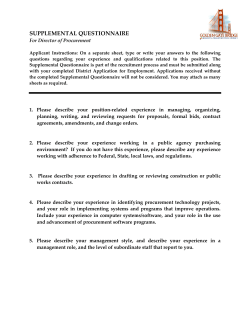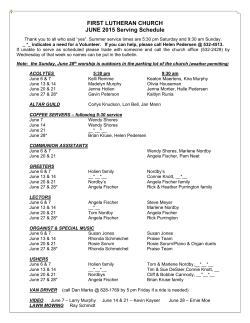
Instructor Supplement 24 - Welcome to people.pharmacy.purdue
Instructor Supplemental Solutions to Problems © 2010 Roberts and Company Publishers Chapter 24 Carbohydrates Solutions to In-Text Problems 24.1 (b) The following two of the nine possible Fischer projections of (S)-2-butanol are related by a cyclic permutation of the ethyl, —OH, and the methyl group. 24.2 (b) Turning either projection 180° in the plane of the page establishes that it is identical to the other projection. 24.4 (a) Use a cyclic permutation to transform the given Fischer projection into a standard form in which all of the backbone carbons are in a vertical line. This will show that the —OH group on carbon-5 is on the right. Thus, this aldose has the D-configuration. 24.6 (b) Recognize that D-mannose is epimeric to D-glucose at carbon-2, and thus convert the b-D-glucopyranose structures on text p. 1180 to b-D-mannopyranose structures by inverting the configuration of carbon-2. (d) Start with the Fischer projection for D-fructose from text p. 1177. INSTRUCTOR SUPPLEMENTAL SOLUTIONS TO PROBLEMS • CHAPTER 24 2 (f) Start with the structures of a-D-glucopyranose in the solution for part (e) (p. 644 of the Study Guide and Solutions Manual) and make the bond to the anomeric carbon a “squiggly bond.” (For the Fischer projection simply do not show the configuration. “Squiggly bonds” are not used in Fischer projections.) 24.7 (b) This is the b-anomer of a D-hexopyranose that differs from D-glucose in its configuration at carbons 3 and 4; therefore, it is b-D-gulopyranose. 24.9 The mechanism for base-catalyzed mutarotation of glucose: INSTRUCTOR SUPPLEMENTAL SOLUTIONS TO PROBLEMS • CHAPTER 24 24.11 3 (a) The easiest way to do this is to consider the relationship of D-allose to D-glucose and modify the conformational representation of b-D-glucopyranose (in which all of the ring substituents are equatorial) accordingly. Thus, Fig. 24.3 on text p. 1174 shows that D-allose is epimeric to D-glucose at carbon-3. Consequently, configurational inversion of the b-D-glucopyranose structure at carbon-3 gives the desired conformational representation of b-D-allopyranose. (b) Follow the procedure in Study Problem 24.2 on text p. 1180. Note that in the second and third Fischer projections the configuration of carbon-5 cannot be represented without violating the Fischer-projection conventions. We must remember that this carbon has the R configuration, and this configuration must be shown explicitly in the conformational representation. 24.13 (b) D-Allose would 24.15 Because naturally occurring glycosides generally have bonds between an alcohol or phenol oxygen and the anomeric carbon of a carbohydrate, it is reasonable to propose that the b-D-glycoside of vanillin and glucose has the following structure: be transformed by base into a mixture of D-altrose (structure in Fig. 24.3 on text p. 1174) and the ketose D-psicose. INSTRUCTOR SUPPLEMENTAL SOLUTIONS TO PROBLEMS • CHAPTER 24 4 24.16 (b) Start with the structure of a-D-galactopyranose, which is the same as a-D-glucopyranose except that carbon-4 is inverted. Then substitute an isopropoxy group for the hydroxy group at the anomeric carbon. 24.18 (b) Alkylate all of the hydroxy groups with benzyl chloride (PhCH2Cl), a very reactive alkyl halide; then hydrolyze the benzyl glycoside. (Why is benzyl chloride very reactive? See Sec. 17.4, text p. 802.) 24.19 (b) Notice that ribitol is a meso compound. The structure of the aldaric acid derived from oxidation of D-mannose, and the structure of its 1,4-lactone: 24.21 (b) 24.22 As is the case with carbohydrates, the primary alcohol groups are selectively oxidized by HNO3 (b) INSTRUCTOR SUPPLEMENTAL SOLUTIONS TO PROBLEMS • CHAPTER 24 24.24 The discussion in the solution to Problem 24.23 (p. 647 in the Study Guide and Solutions Manual) shows that the fragment obtained from oxidation of a b-D-pyranoside is the diastereomer of the fragment obtained from oxidation of an a-D-pyranoside. Diastereomers have different properties. Hence, these fragments, which can in principle be identified by their properties, including their optical rotations, can be used to determine whether the original pyranoside was a or b. This method works not only for the methyl galactopyranosides, but for all pyranosides. (Periodate oxidation was used to determine the anomeric configurations of many pyranosides before modern spectroscopic tools were available, and these results have withstood the scrutiny of modern analytical methods.) 24.27 Compound A is D-gulose, because it gives the same aldaric acid as L-glucose. The fact that some aldaric acids can be derived from two different aldoses is also addressed in Problem 24.20 in the Study Guide and Solutions Manual. The same point is discussed in Study Guide Link 24.2 on p. 633 of the Study Guide and Solutions Manual. In contrast, D-idose is the only aldohexose that can be oxidized to its aldaric acid. 24.29 In such a case, the structure of D-(+)-glucose, indeed, the structures of all D-carbohydrates, would be the enantiomers of the structures shown in Fig. 24.3 on text p. 1174. 24.31 Because cellobiose is a dimer of D-glucose, it is hydrolyzed by aqueous acid into two molar equivalents of Dglucose. 5 INSTRUCTOR SUPPLEMENTAL SOLUTIONS TO PROBLEMS • CHAPTER 24 6 Solutions to Additional Problems 24.34 Note that carboxylic acids derived from carbohydrates usually exist as lactones, and aldoses exist primarily as cyclic hemiacetals. For simplicity they are represented below in their noncyclic forms. (a) (b) (c) (d) (e) 24.35 (b) Remember that there are several valid ways to draw the chair conformations of pyranoses. Because the text probably has made you accustomed to seeing b-anomers with equatorial groups at carbon-1, you may be thinking that the chair conformation in the solution to part (b) shows the a-anomer. However, this is a correct representation of the b-anomer. Whether the b-anomer has an equatorial or axial group at the anomeric carbon depends on which chair conformation you choose to draw. The following equally valid representations of a different chair conformation of the same compound do have the group at the anomeric carbon in an equatorial position. INSTRUCTOR SUPPLEMENTAL SOLUTIONS TO PROBLEMS • CHAPTER 24 7 27.36 (b) This pyranose is epimeric to b-D-glucopyranose at carbon-3. Consult Fig. 24.4 on text p. 1174 to discover that the aldohexose epimeric to glucose at carbon-3 is allose. Therefore, this compound is b-D-allopyranose. 24.37 (b) An achiral ketopentose must be a meso compound: (d) Derivation of the structure of b-D-idofuranose from the Fischer projection: This is identical to the structure in the solution to Problem 24.11b except for the configuration at the anomeric carbon. 24.38 (b) (d) (f) Diastereomers and epimers Constitutional isomers The two names describe the same structure. 24.39 (b) (d) (f) L-Sorbose is (h) (j) 24.41 a ketohexose, or hexulose. not an aldohexose; it is a ketohexose, as noted in the solution to part (b). This compound is epimeric to L-sorbose at carbon-5, and thus it is not a form of L-sorbose. In fact, it is Dfructose. This structure is the enantiomer of the structure in part (g), and thus it is not a form of L-sorbose. (It is the afuranose form of D-sorbose.) This is an aldopyranose and therefore cannot be a form of L-sorbose. (It is b-D-glucopyranose.) L-Sorbose is The structure of 3-O-b-D-glucopyranosyl-a-D-arabinofuranose: INSTRUCTOR SUPPLEMENTAL SOLUTIONS TO PROBLEMS • CHAPTER 24 8 27.43 (b) D-Ribose gives 24.44 (b) Any 3- or 4-hydroxy aldehyde, like a carbohydrate, will form a cyclic acetal in acidic methanol. (d) Cyclohexene reacts with OsO4 to give cis-1,2-cyclohexanediol, which forms a cyclic acetal with acetone. (f) Ethanolysis of the acetal linkage occurs in ethanol just as hydrolysis occurs in water. An ethyl pyranoside is also formed from the glucose residue at the reducing end of lactose. (a) This is an isotopically labeled analog of glucose, and is prepared by the Kiliani–Fischer synthesis shown in Eqs. 24.43 and 24.44 on text p. 1198, except that radioactive sodium cyanide (Na14CN) is used instead of ordinary NaCN. In this synthesis, 14C-D-mannose will be a by-product. This compound is prepared in the same way as the compound in (a), except that ordinary (unlabeled) NaCN is used, and the reduction is carried out with tritium-enriched hydrogen (3H2). In this synthesis, 3H-Dmannose will be isolated as a by-product. The synthesis of compound (c) requires removal of an unlabeled carbon from D-arabinose, replacing it with a labeled carbon, and then completion of an ordinary Kiliani–Fischer synthesis to give labeled mannose. (* = 14 C) 24.45 (b) (c) the same osazone as D-arabinose because D-ribose is epimeric to D-arabinose at carbon-2. Each of the last two reactions also gives epimeric sugars—D-ribose and D-glucose, respectively—as byproducts. INSTRUCTOR SUPPLEMENTAL SOLUTIONS TO PROBLEMS • CHAPTER 24 24.47 (a) 24.48 Since the product of the decarbonylation reaction is optically inactive, compound B must be meso-(2R,3S)-butane1,2,3,4-tetraol (erythritol) in which all of the —OH groups are on the right side in the Fisher projection, Thus, the aldopentose A is either D-ribose or D-arabinose (see Fig. 24.3, text p. 1174). 9 The products from the Kiliani–Fisher synthesis would then be either D-allose and D-altrose or D-glucose and text p. 1174). Since both of the products from the nitric acid oxidation are optically active, that means that D-allose could not be a product from the Kiliani–Fisher synthesis because it would produce an optically inactive aldaric acid. Thus, A is D-arabinose, C and D are D-glucose and D-mannose, and E and F are Dglucaric acid and D-mannaric acid. (See Eqs. 24.43–44, text p. 1198, for the Kiliani–Fisher synthesis using Darabinose as the starting aldose.) D-mannose (see Fig. 24.3, 24.49 The extract of mouse spleen evidently contains enzymes that catalyze the removal of a phosphate as well as the conversion of ribose into an optically inactive isomer. Ribitol and xylitol are the alditols derived from ribose and xylose, respectively, and therefore are epimeric at carbon-3. Compound X has one degree of unsaturation, and, because reduction gives alcohols that are epimeric at carbon-3, compound X is a 3-ketopentose. The structure for X shown in the following transformation fits the data: INSTRUCTOR SUPPLEMENTAL SOLUTIONS TO PROBLEMS • CHAPTER 24 24.53 10 The residue at the nonreducing (“left”) end undergoes the following transformation: The internal residues undergo the following transformation: The residue at the reducing (“right”) end gives erythritol, ROH, and two equivalents of formic acid (HCO2H). (Demonstrate this for yourself; see Eq. 24.39 on text p. 1196.) Erythritol therefore results from the cleavage reactions of all residues except for the one at the nonreducing end; and glycerol results from cleavage of that residue. Thus, glycerol is produced from one residue, and erythritol is produced from n – 2 + 1 = n – 1 residues. Since n = 12, eleven moles of erythritol per mole of glycerol are formed. 24.55 The hydrolysis of planteose by almond emulsin establishes that an intact sucrose unit is connected to a galactose residue by an a-galactosyl glycosidic bond. The question, then, is which oxygen of the sucrose residue is involved in the glycosidic linkage to the galactose. Methylation followed by hydrolysis provides the answer. (It will be helpful to refer to the structure of sucrose on text p. 1207.) If the fructose residue of sucrose were not connected to the galactose, it would have four oxygens available for methylation: the oxygens at carbons 1, 3, 4, and 6. Because the oxygen at carbon-6 is not methylated, it must be the point of attachment of the galactose residue. Hence, the structure of planteose is as follows: INSTRUCTOR SUPPLEMENTAL SOLUTIONS TO PROBLEMS • CHAPTER 24 24.56 11 (a) The hydroxy groups of cellulose react with the anhydride to introduce succinate half-esters into the cellulose structure, as follows. (In these equations. HO —cellulose means any of the hydroxy groups of cellulose.) (b) Sizing introduces a large number of alkyl groups into the cellulose structure. These resist solvation by water for the same reasons that hydrocarbons are insoluble in water; they are “hydrophobic” groups. Hence, these groups tend to resist the incorporation of solvent water into the cellulose structure. Furthermore, many of the —OH groups in the cellulose, which are hydrogen-bond donors before the reaction, become ester oxygens as a result of the reaction and therefore can no longer donate hydrogen bonds. As the reaction in the solution to part (a) shows, the carboxylic acid groups introduced by the reaction are ionized by the pH 7 treatment because their pKa values are well below the pH of the solution. When the paper is dried, these groups are left in their ionized state (with an appropriate counter-ion). The carboxylate groups are the slightly basic groups. For example, when they come into contact with water, they react with water to produce a small amount of hydroxide ion: (c) You can use the pKa value for the carboxylic acid and the ion-product constant of water to calculate that the pH of an aqueous solution of a carboxylic acid salt should have a pH of around 9. Hence, when the “sized” paper comes into contact with acid, the acid is neutralized by the small amount of hydroxide ion present. So many carboxylate groups are present that the hydroxide ion is immediately replenished, by Le Châtelier’s principle. 24.58 This transformation is essentially a Lobry de Bruyn–Alberda van Ekenstein reaction, the detailed mechanism of which is shown in Eqs. 24.22–24.23 on text pp. 1186–7. The aldehyde form of D-glucosamine is in equilibrium with a small amount of its enol A. This enol is also an enamine, which is in equilibrium with an imine B. Because imine formation is reversible in aqueous acid and base, the imine hydrolyzes to give the corresponding ketose, D-fructose, along with the by-product ammonia. Under the basic conditions, D-fructose is also in equilibrium with D-glucose and D-mannose, as shown on text p. 1186. INSTRUCTOR SUPPLEMENTAL SOLUTIONS TO PROBLEMS • CHAPTER 24 12
© Copyright 2024









